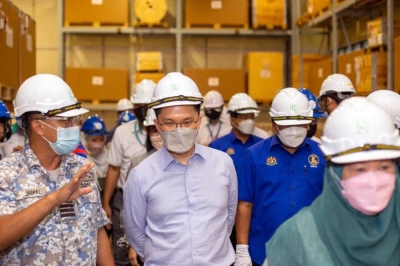This should actually be in the RMAF thread but since it concerns MPAs I've posted it here.
A press release from the USN.
NAVAL AIR WARFARE CENTER AIRCRAFT DIVISION, PATUXENT RIVER, Md.–The U.S. Navy has delivered the first of 3 Royal Malaysian Air Force CN-235 military transport aircraft converted to a maritime patrol platform. This comes just three-and-a-half years after the U.S. signed a Letter of Offer and Acceptance to begin increasing the capability and interoperability of U.S. and Malaysian forces.The effort was facilitated by the U.S. Navy’s Building Partner Capacity program, aligned with the U.S. government’s Maritime Securityn Initiative, which is intended to assist the Malaysian government in increasing maritime security and maritime domain awareness within the Malaysian Exclusive Economic Zone.
The project to integrate an Intelligence, Surveillance and Reconnaissance (ISR) upgrade into the aircraft was undertaken by the RMAF in cooperation with the Naval Air Systems Command’s Security Cooperation Office and Naval Air Warfare Center Aircraft Division AIRWorks.Our collective international team has overcome tremendous challenges during the recent worldwide pandemic to deliver this capability. We are excited to deliver this first aircraft,” said Gerald Swift, who leads AIRWorks, NAWCAD’s office focused on rapidly and effectively delivering warfighter capability to meet immediate and emergent warfighter needs.
The upgrade includes a maritime surveillance mission suite, maritime surveillance radar, an electro-optical infrared turret, line-of-sight datalink and a roll-on/roll-off mission system operator station. Compatible mobile and fixed ground stations are also being delivered to increase the RMAF’s ISR capability. Building Partner Capacity programs represent the highest level of return on engagement to the United States,” said Ron Weinberger, director, Security Cooperation Office at the Naval Air Systems Command. The Malaysian CN-235 program will be a significant force multiplier to an indigenous Malaysian ISR capability and will directly support joint Malaysian and U.S. efforts to ensure global security in the Indo-Pacific Command area of responsibility.
The project’s CN-235s were flown to Indonesia for completion and testing in Sept. 2020 amid COVID-19 restrictions and first flight took place in Oct. 2021. Work on the two remaining CN-235 aircraft and multiple ground stations continues and is expected to be completed in 2022."
The 6 CN-235s were originally acquired to replace the retired Carobou fleet. Originally there were plans for 32 and as part of the deal Malaysia was to have supplied some 2,000 Proton cars and a number of Aerotigas [a prop driven light aircraft]. Delivery was slightly delayed due to certification issues with IPTN. Since entering service the 6 CN-235s have performed multiple roles such ranging from mercy flights; SAR, as rain makers, light transport to jump training. The type use to frequent the southern Philippines in support of the MAF's IMT and regularly delivers personally and cargo to Layang-Layang the country's largest reef in the Spratlys.
The operator was originally 21 Squadron which relocated from Subang to Kuching [were the simulator is located] some years ago and has since been redesigned 1 Squadron. Their conversion into MPAs [officially designated MSAs] significantly improves the country's ability to safeguard its maritime domain.


:quality(70)/cloudfront-us-east-1.images.arcpublishing.com/archetype/B73XTXUUHBEORKGGGI44M7UMWI.jpg)


